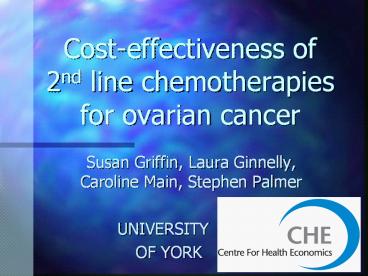Cost-effectiveness of 2nd line chemotherapies for ovarian cancer
1 / 19
Title:
Cost-effectiveness of 2nd line chemotherapies for ovarian cancer
Description:
Susan Griffin, Laura Ginnelly, Caroline Main, Stephen Palmer. UNIVERSITY. OF YORK ... Systematic review of existing clinical effectiveness and cost ... –
Number of Views:34
Avg rating:3.0/5.0
Title: Cost-effectiveness of 2nd line chemotherapies for ovarian cancer
1
Cost-effectiveness of 2nd line chemotherapies for
ovarian cancer
- Susan Griffin, Laura Ginnelly, Caroline Main,
Stephen Palmer - UNIVERSITY
- OF YORK
2
The NICE process
- Systematic review of existing clinical
effectiveness and cost-effectiveness evidence - Includes an estimate of cost-effectiveness of
technology considered - NICE have specified Reference Case
- Probabilistic
- Use generic preference-based measure of quality
of life - Costs from the perspective of the NHS
3
Overview
- Probabilistic decision analytic model from UK
perspective - Life time costs and quality-adjusted life-years
(QALYs) - Assesses topotecan, paclitaxel and pegylated
liposomal doxorubicin hydrochloride (PLDH) - Other comparators include platinum (carboplatin
and cisplatin), paclitaxelplatinum,
cyclophosphamidedoxorubicincisplatin (CAP)
4
Patient groups
- Response to 1st line platinum therapy predictive
of response to subsequent therapy - Consider 2 separate cohorts
- Relapse greater than 6 months following 1st line
therapy PLATINUM SENSITIVE - Relapse within 6 months or failure to respond
- PLATINUM RESISTANT/REFRACTORY
5
Model structure
- Objective estimate lifetime costs and QALYs
- Calculate survival as sum of 2 distinct periods
- Progression-free period
- Period from progression to death
- Quality adjust each period to calculate QALYs
- Costs only 2nd-line treatment, admin and adverse
events
6
Diagram of model structure
mean_surv
Stable Disease
Progressive Disease
Dead
mean_ttp
(mean_surv - mean_ttp)
Key mean_surv mean (overall) survival
time mean_ttp mean time to progression
7
Comparisons in RCTs
8
Main challenges
- No direct trial comparison of all relevant
therapies - Incorporating ICON4
- No data on absolute hazards or mean survival
- Lack of quality of life (QoL) data
- In particular no utility data for toxicity events
reported in trials
9
1. Approach to lack of direct comparison
- Bayesian mixed treatment comparison (MTC) to
calculate relative effects - Synthesise (log) hazard ratios ?
- Log(HRPac_Top) N(?Pac_Top, ?2Pac_Top)
- Extends standard meta-analysis to include
principle of transitivity - Assume ?Pac_PLDH ?Pac_Top ?Top_PLDH
10
2. Incorporating ICON4
- Problem
- No common comparator with other trials
- Only trial data for 2 relevant comparators in
platinum sensitive - Solution
- Use exponential approximation to calculate
absolute hazard - Calculate relative effect versus topotecan by
taking ratio of absolute hazards - LIMITATION breaks randomisation
11
3. Baseline in the model
- Selected topotecan to provide baseline
- Most comprehensive available data
- No trials included best supportive care
- Calculate absolute hazard ? from median survival
using exponential approximation - ? -LN(0.5)/t t median survival (weeks)
- Var(?) ?2/r r events
- mean survival (weeks) 1/ ?
12
4. Quality of Life
- No utility data available for toxicity events
reported in trials - As treatment is palliative, QoL important
- Available data
- Utility stable advanced ovarian cancer 0.63
- Utility decrement of move from stable to
progressive advanced breast cancer - Apply relative decrement to 0.63 as proxy
- Important area for future research
13
Populating the model
- Used direct output from evidence synthesis model
in WinBUGS for treatment effects including
adverse events - Characterised other inputs using appropriate
distributions to incorporate uncertainty
14
Results Platinum resistant/refractory
15
Results Platinum sensitive
16
CEAC platinum resistant/refractory
17
CEAC for platinum sensitive
18
Choice of comparators
- Broke randomisation to include ICON4
- If ICON4 excluded, CAP appears cost-effective in
platinum sensitive - CAP no longer used in practice
- Lack of available data may mean side effects not
fully reflected in model - If CAP excluded, ICER for paclitaxel combination
versus platinum 19,926 - If exclude CAP and ICON4, PLDH appears
cost-effective for platinum sensitive
19
Final thoughts
- MTC approach
- allows incorporation of trials otherwise
discarded - still faced with choice of which trials to
include - works best with complete network
- Implications for future work
- Extend search strategy/systematic review to pick
up all relevant trials and ? likelihood of
complete network































